If you’re like me, you have probably wondered at one time or another if it’s safe to mix bleach and Borax together.
I mean, they are both cleaning products, so it seems like they would work well together, right?
You can definitely mix bleach and borax together. When these two substances are combined, they can work even harder to remove the odors and stains on your clothes while deeply whitening them. Since both substances are alkaline, they won’t produce noxious fumes.
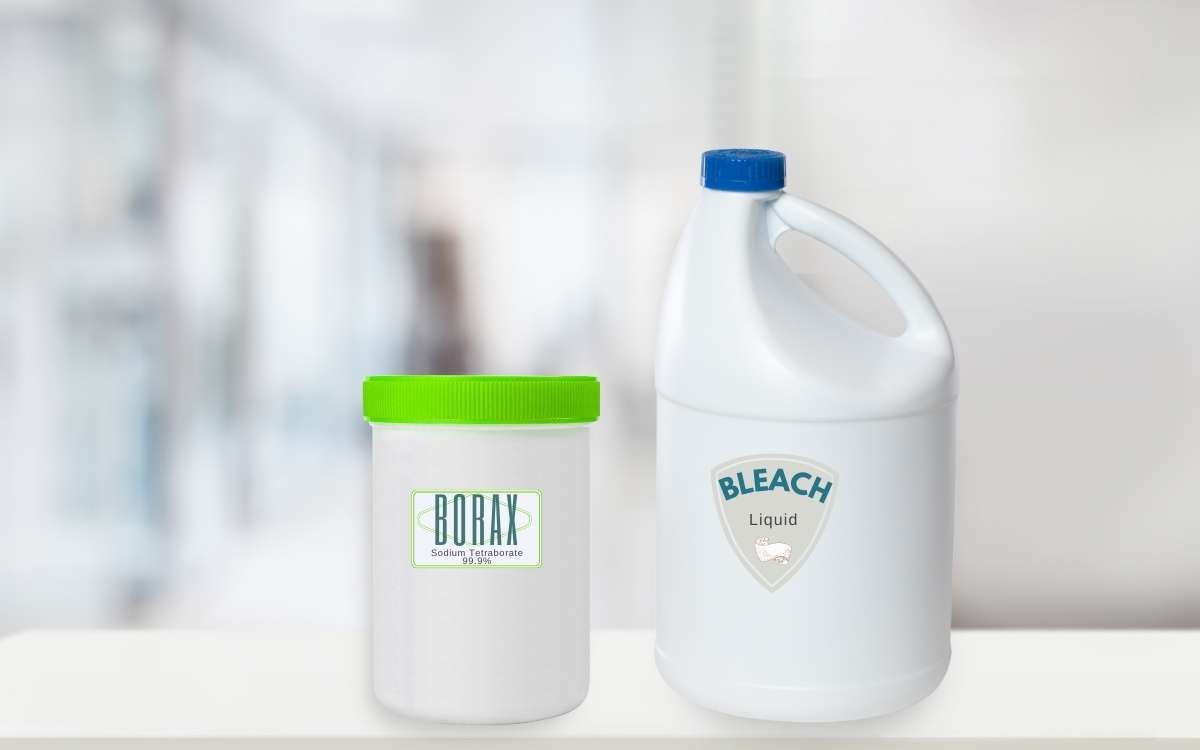
It’s important to keep in mind that this doesn’t mean that you should start mixing these two products together willy-nilly.
You should always take care when using bleach, and be sure to follow the instructions on the label.
Read on to learn more about these two substances, and how to safely mix them together.
Table of Contents
What Happens When You Mix Borax and Bleach?
When borax is added to bleach, it intensifies the bleach’s effects. This is because borax is an alkaline substance, and it raises the pH level of bleach.
The increased pH level makes chlorine bleach more effective at removing stains and whitening clothes.
In addition, when you mix Borax with bleach, it produces oxygen. This oxygen helps to break down the stains on your clothing, making them much easier to remove.
How to Mix Borax and Bleach
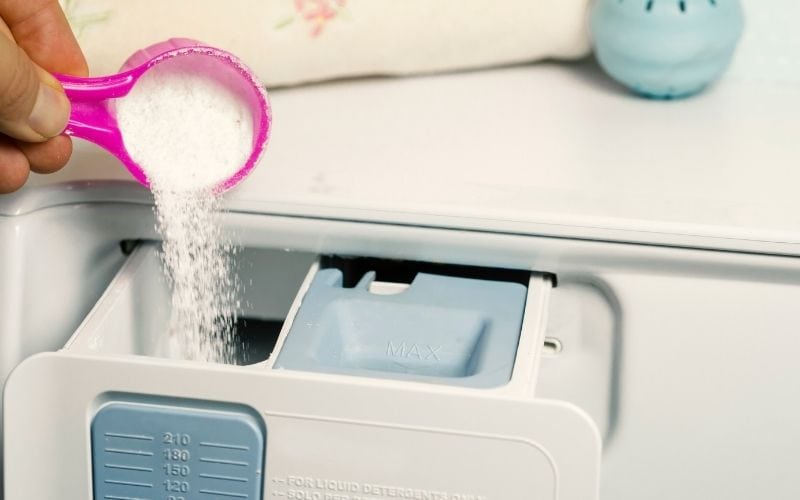
Now that you know it’s safe to mix these two substances together, you’re probably wondering how to go about doing it. It’s very easy to combine these two products!
The good news is that it’s actually pretty simple. All you need to do is add ½ cup of Borax to your wash cycle along with your regular detergent and bleach.
You can also make a paste out of Borax and bleach, which can be used to pre-treat particularly stubborn stains.
To do this, simply mix together equal parts of Borax and bleach, and apply the paste to the stain. Let it sit for a few minutes before washing as usual.
As always, be sure to exercise caution when using chlorine bleach. Never mix it with other chemicals, and always follow the instructions on the label.
Keep pets and small children away from the area where you’re mixing borax and bleach.
The Benefits of Using Borax and Bleach in Your Laundry
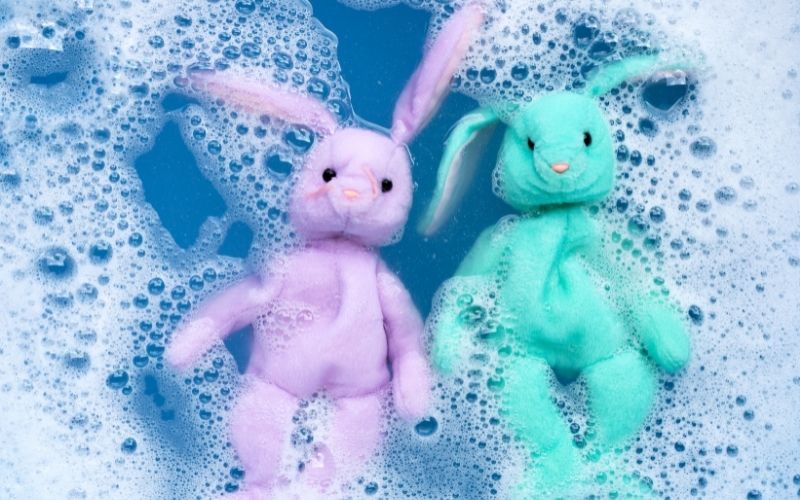
If you’re thinking about adding Borax to your laundry routine, you’re on the right track. This simple change can make a big difference in the way your clothes look and smell.
Here are some of the top benefits of using these two household products:
It Removes Soap Residue From Laundry
If you’ve ever noticed that your clothes don’t seem to be getting as clean as they should be, it might be because of soap residue.
This can happen if you don’t use a good quality detergent, or if you have hard water.
Borax can help to remove this soap residue, leaving your clothes feeling less stiff, softer, and overall cleaner.
It Removes Tough Mold Stains and Odors
Mold stains and odors can be tough to get rid of, but they’re no match for Borax paired with Bleach. These substances are great at eliminating pests, fungi, bacteria, and mold.
Simply add ½ cup of Borax alongside chlorine bleach to your wash cycle, and you’ll notice a big difference.
It Helps With Stain Removal
As you know, bleach is meant for stain removal. However, it’s not always as effective as we would like it to be. This is where Borax comes in.
When you add Borax to your wash cycle, it helps to break down the stains on your clothes, making them much easier to remove.
Just make sure to keep any dark or delicate items out of the wash when you’re using Borax, as it can cause them to fade.
It Makes Your Hard Water Softer
Water is hard because of the minerals that are dissolved in it, such as calcium and magnesium. These minerals can build up on your clothes over time, making them feel stiff and rough.
Borax can help to break down these minerals, making your water softer and your clothes cleaner. This is because it’s a water softener.
You can add it to your laundry routine, or you can use it to pre-treat clothing so that it’s a bit more resistant to hard water.
What Else Can I Safely Mix Chlorine Bleach With?
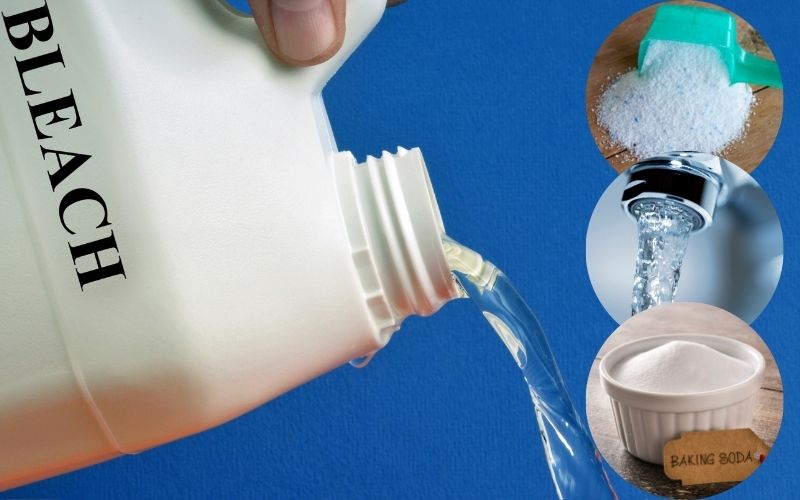
When it comes to laundry, there are a few other household products that you can mix chlorine bleach with:
Baking Soda
Baking soda is made of sodium bicarbonate, which is a mild alkaline substance. When you mix baking soda with bleach, it produces oxygen.
This oxygen helps to break down the stains on your clothing, making them much easier to remove. Oxygen bleach solutions are also great at removing mold and mildew.
Water
If you’re looking to dilute the strength of your bleach solution, adding water is a great choice. This can help to reduce toxic fumes and make the solution less harsh on your clothing.
This makes it safer to use this powerful cleaning agent around children and pets and can also help to prolong the life of your clothing.
Laundry Detergent
Washing detergent can help to boost the cleaning power of your bleach solution. This is because it contains surfactants, which are chemicals that help to break down dirt and grime.
Simply add a cup of laundry detergent to your bleach solution, and you’ll notice a difference in the way your clothes come out of the wash load.
What is Borax Made Of?
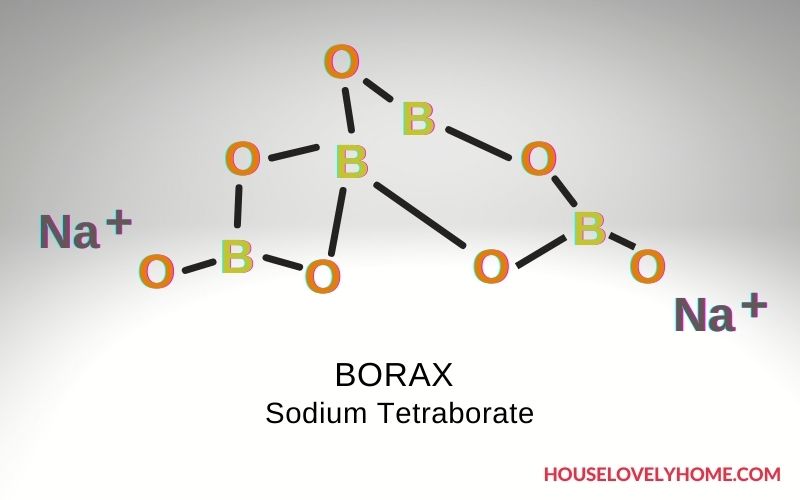
Borax, also known as Sodium Tetraborate, is made of boric acid, which is a white powder that’s derived from boron. Borax is a combination of oxygen, sodium, and the boron element.
It’s naturally occurring and can be harvested from salt mines. It has a wide range of uses and is known as a multi-purpose cleaner.
Borax is an effective cleaning agent because it’s a powerful disinfectant. It’s also great at removing mold and mildew.
Additionally, it can help to soften hard water, making it ideal for laundry use.
Borax is safe to use around children and pets when used as directed. However, you should always keep it out out of the reach of children.
Uses for Borax
This cleaning agent can be used for a variety of purposes, including:
DIY All-Purpose Cleaning Spray
If you want to save money on store-bought cleaning solutions, you can make your own all-purpose cleaner using Borax.
Mix ¼ cup of Borax with half a gallon of water and add it to a spray bottle. This solution can be used to clean countertops, floors, appliances, and more.
Laundry Booster
As mentioned above, Borax can help to boost the cleaning power of your laundry detergent. This will help to remove stains, and odors, and will overall brighten and soften your whites.
Pest Control
Borax can also be used as a pest control agent. It’s effective at killing ants, roaches, and other household pests.
Simply mix Borax with sugar and water to create a bait that will lure the pests into it.
You can also sprinkle Borax around the perimeter of your home to keep pests away. The boric acid i
n Borax is toxic to pests, so they will stay away from it.
Weed Killer
Borax can also be used as a weed killer. This is because it’s a salt, and salt is known to kill plants.
Simply mix Borax with water and pour it onto the weeds you want to get rid of. The Borax will dehydrate the weeds, killing them within a few days.
Make sure you don’t pour Borax on any plants you want to keep, as it will kill them as well.
Window and Glass Cleaner
You can also use Borax to clean your windows and glass surfaces. Simply mix it with water and vinegar to create a streak-free solution that will leave your windows sparkling clean.
Furniture Polish
Borax can also be used to polish wood furniture. Simply mix it with olive oil and lemon juice to create a natural furniture polish.
This solution will help to nourish your wood furniture and w
ill leave it with a beautiful shine.
Oven Cleaner
You can also use Borax to clean your oven. Simply mix it with water and vinegar to create a powerful cleaning solution that will remove all the grime and build-up in your oven.
Bleach Whitening Alternatives
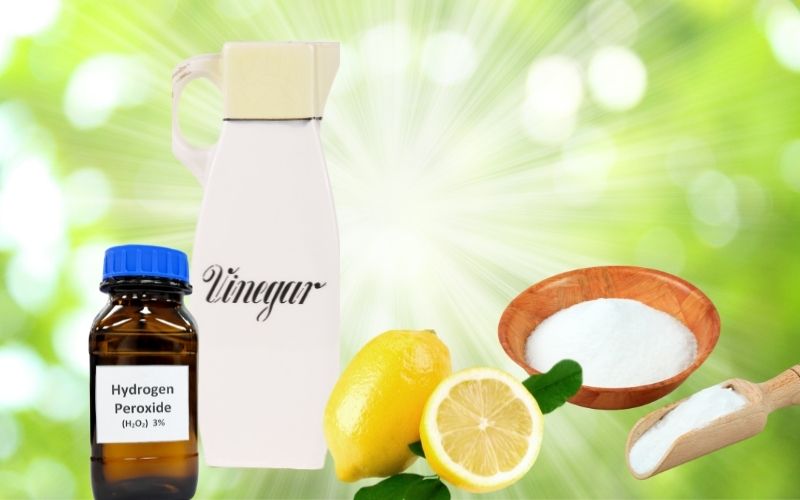
If you’re looking for a bleach alternative that’s safe to use around children and pets, here are some effective and affordable options:
Hydrogen Peroxide
Hydrogen Peroxide is known for its ability to deeply disinfect and whiten surfaces. It’s a great alternative to bleach and can be used on a wide range of surfaces, including countertops, tile, and grout.
To use hydrogen peroxide as a bleach alternative, simply mix it with water at a ratio of one part hydrogen peroxide to three parts water.
Then, apply it to the surface that you’re cleaning and let it sit for at least five minutes.
Vinegar
Vinegar is a great all-purpose cleaner that can be used as a bleach alternative. It’s made of acetic acid, which is a natural disinfectant.
Vinegar is also great at removing dirt, grime, and mold. Use it to help break down excessive buildup on household surfaces or in clothing.
Lemon Juice
Using lemon juice is one of the great natural cleaning techniques. Its cleaning properties have been noted for hundreds of years.
It’s made of citric acid, which is a natural disinfectant. Lemon juice is also great at removing dirt, grime, and mold.
The best part about this solution is that it’s all natural and non-toxic for other family members. It’s also an affordable solution you can find in the produce section of your store.
Baking Soda and Salt Paste
This is another great alternative to chlorine bleach that’s perfect for cleaning grout.
To make this paste, simply mix together equal parts of baking soda and salt. Then, add enough water to make a thick paste.
Apply it to the grout that you’re trying to clean and let it sit for at least five minutes before scrubbing it away.
Sunlight/UV
Did you know that good old sunlight is a powerful disinfectant? UV rays are great at killing bacteria and viruses.
It also naturally bleaches surfaces, making it a great alternative to bleach.
To use sunlight as a disinfectant, simply place the items you’re trying to clean in direct sunlight for at least six hours.
This is a great way to naturally disinfect and whiten clothing, linens, and other household items.
Just make sure that these items are able to withstand the heat and UV rays of the sun.
The Bottom Line
It’s important to know which substances are safe to combine. When mixing Borax and chlorine bleach, you should be careful and always test the mixture in an inconspicuous area first.
These two solutions are affordable and effective alternatives to expensive store-bought cleaners. By using them together, you can save money and time while still getting your home clean and your laundry fresh.
If you’re looking for a natural alternative to bleach, there are plenty of options available.
Hydrogen peroxide, vinegar, lemon juice, and sunlight are all great disinfectants that can be used in addition to or in place of bleach.
Whatever you choose, be safe and keep the kiddos away!
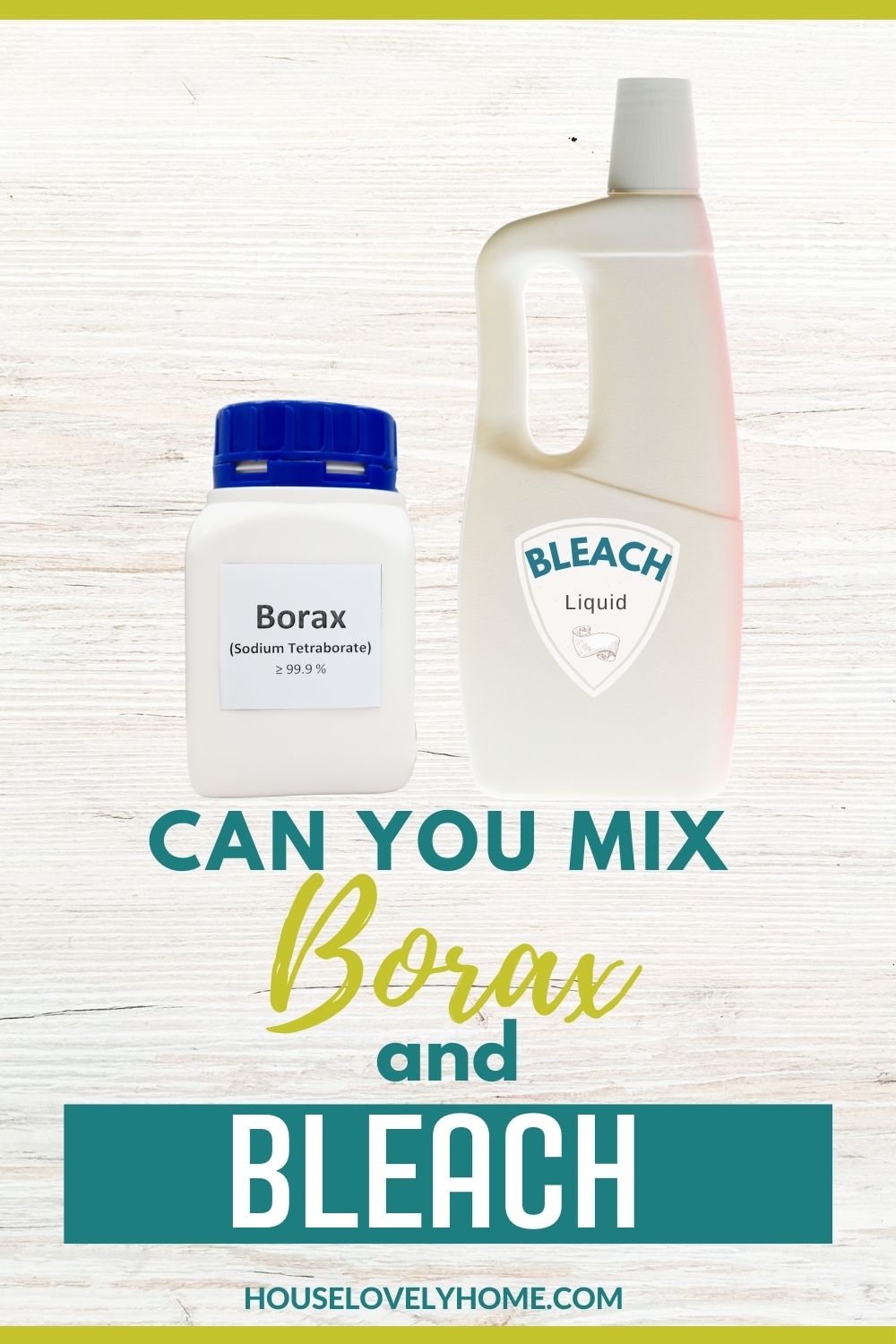

Borax, an alkaline mineral is a sodium salt of boric acid, a separate natural mineral.
Boric acid can be made from borax by addition of hydrogen.
Made FROM and made OF are very different statements. They are related but so are water and hydrogen peroxide or baking soda and washing soda.
Where you’re discussing combining household chemicals for the benefit of non-chemist consumers, generalizations can be unintentionally misleading.
Hi ML, appreciate your input. Always happy to be corrected – feel free to email me with your concerns and we will update this article if needed.